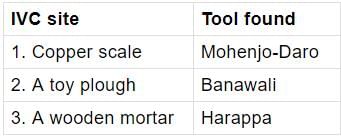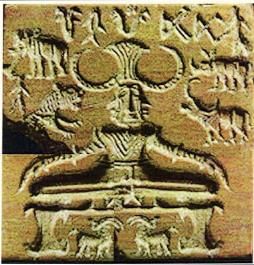Test: Religion, Sculptures & Seals - UPSC MCQ
15 Questions MCQ Test Additional Study Material for UPSC - Test: Religion, Sculptures & Seals
In which of the following site, the terracotta sculpture of the Mother Goddes is found?
Which of the following materials was mainly used in the manufacturing of Harappan seals?
Consider the following statements concerning the Indus valley people stone sculpture:
1. They used red, grey sandstone and steatite.
2. A red sandstone figure of a naked male torso was found in Banawali
Which of the statements given above is/are correct?
1. They used red, grey sandstone and steatite.
2. A red sandstone figure of a naked male torso was found in Banawali
Which of the statements given above is/are correct?
Consider the following statements regarding the IVC people metal sculpture:
1. They used the Lost Wax Technique for creating sculptures
2. The dancing girl from Mohen-jo-Daro was standing in the swastika dance posture.
3. They created bronze animal figures as well.
Which of the statements given above is/are correct?
Which of the following animal was not found on the seal depicting the male deity (Pasupati Mahadeva)?
Consider the following statements concerning the use of seals by the Indus Valley People :
1. The seals were used for the identification of the trader.
2. The seals were used for decorative amulets.
3. The seals were used for educational purposes.
Which of the statements given above is/are correct?
Consider the following statements:
1. The Indus Valley Civilization pottery had inconsistency in its structure.
2. Red and Black pottery were more prevalent.
Which of the statements given above is/are correct?
Which of the following tree the Indus people considered as their sacred one?
Consider the following statements concerning the Indus people religious life:
1. The Indus people probably believed in an after-life.
2. The religion had held a dominating sway over the daily lives of the masses.
Which of the statements given above is/are correct?
Which of the following material was not used for making tools during the Indus Valley Civilization?
In which of the following site the angle measuring instruments were found?
Consider the following pairs:

Which of the pairs given above is are correct?
Consider the following statements concerning the Indus script:
1. The script has more than two thousand signs.
2. The script was usually written left to right.
Which of the statements given above is/are correct?
In which of the following site, an example of a double burial has been discovered?
Consider the following statements concerning the Indus valley Burial Practices:
1. A dog buried with human oval pit burials was discovered in Ropar.
2. The placing of the body in a foetal position is the hallmark of the later phase of IVC.
3. The separate burial pits for dogs were discovered in Kashmir
Which of the statements given above is/are correct?
|
20 videos|561 docs|160 tests
|





















